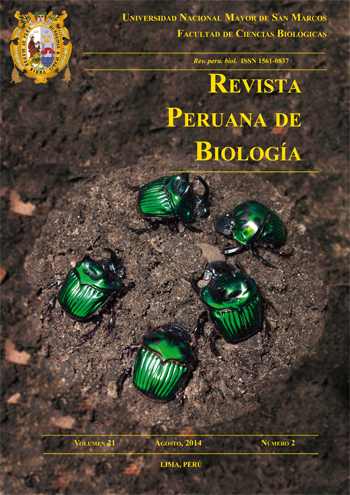Phytoremediation capacity of five high andean species from soils contaminated with heavy metals
DOI:
https://doi.org/10.15381/rpb.v21i2.9817Keywords:
phytorestauratión, peruvian plants, andean ecosystems, phytostabilization, mine waste.Abstract
Phytoremediation consist in the use of plants to recover soil, sediments, water and air in situ, which have been contaminated by organic waste, nutrients or heavy metals, by removing pollutants from the environment or making them harmless. The evaluation work was conducted under greenhouse conditions in Lachaqui, Canta, Lima, from October 2011 to October 2012. Twenty treatments were evaluated with a 5 x 4 factorial design: 5 high elevation Andean species, and 4 substrates with 30%, 60%, 100% mine waste (MW) and tailings soil without MW. In Solanum nitidum, Brassica rapa, Fuertesimalva echinata, Urtica urens and Lupinus ballianus, the biomass production decrease significantly with the of 100 % mine waste treatment (MW). The major efficiency accumulation of lead and zinc was obtained in the roots of Fuertesimalva echinata with 100 % MW treatment, obtaining 2015.1 mg of lead kg-1 DM and 1024.2 mg of zinc kg-1 DM, this specie presented the major tolerance index (TI) to 100 % MW treatment, with 41.5 % TI. The highest cadmium accumulation was obtained in the roots of L. ballianus, with a concentration of 287.3 mg kg-1 DM with 100 % MW treatment, this species also had a 67.9% TI in 60% MW treatment. And finally, S. nitidum presented a 68.5 % TI in 60% MW treatment.Downloads
Downloads
Published
Issue
Section
License
Copyright (c) 2014 Enoc Jara-Peña, José Gómez, Haydeé Montoya, Magda Chanco, Mauro Mariano, Noema Cano

This work is licensed under a Creative Commons Attribution-NonCommercial-ShareAlike 4.0 International License.
AUTHORS RETAIN THEIR RIGHTS:
a. Authors retain their trade mark rights and patent, and also on any process or procedure described in the article.
b. Authors retain their right to share, copy, distribute, perform and publicly communicate their article (eg, to place their article in an institutional repository or publish it in a book), with an acknowledgment of its initial publication in the Revista Peruana de Biologia.
c. Authors retain theirs right to make a subsequent publication of their work, to use the article or any part thereof (eg a compilation of his papers, lecture notes, thesis, or a book), always indicating its initial publication in the Revista Peruana de Biologia (the originator of the work, journal, volume, number and date).






